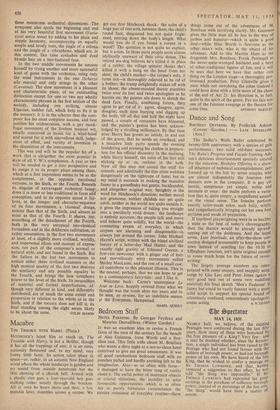Vaughan Williams
THE latest symphony by Vaughan Williams, No. 8, in D minor, played for the first time at a Halle concert in Manchester last week, shows the composer once again larking about with orchestral instruments,.a pastime he has begun to show a strong taste for lately. To the Romance for mouth-organ, the Concerto for tuba, and the Sinfonia Antartica, with its wind-machine, organ, women's voices and huge percussion group, he has now added the Toccata alle Campanelle which forms the mercifully brief finale to the new symphony.
Except for the optional addition of three tuned gongs 'as used in Puccini's Turandot,' the percussion group here, like the rest of the orchestra, is slightly smaller than in the Antartica, but it is much more obtrusive, for want of any similar programmatic-musical justification. The toccata combines the maxi- mum of noise with the minimum of music— and that not the kind of music that sounds best, or even at all effective, blown up to these monstrous orchestral dimensions. The composer also spoils the beginning and end of his very beautiful first movement (Varia- zioni senza tema) by adding to his plain and simple harmony, accompanying an equally simple and lovely tune., the jingle of a celesta and the jangle of a vibraphone, which are, in this context, like false eyelashes and dyed blonde hair on a fine-featured face.
In the two middle movements he amuses himself by trying another and more successful kind of game with the orchestra, using only the wind instruments in the one (Scherzo ella marcia) and only strings in the other (Cavatina). The slow movement is a pleasant and characteristic piece, of no outstanding distinction except for one or two not wholly characteristic phrases in the first section of the melody, including one striking, almost Elgarian, sudden fall, which help to fix it in the memory. It is in the scherzo that the com- poser has his most complete success, and best justifies his orchestration, with a gay mock- fugal movement of the liveliest musical wit, ideally conceived as music for a wind-band and scored for it with marvellous skill, judge- ment of effect, and variety of invention in the disposition of the instruments.
This was and will be the popular hit of a work that is altogether the most popular in style of all V. W.'s symphonies. A year or two will be needed to get it into perspective and to assign it to its proper place among them, which at a first impression seems to be as the complement, at the opposite emotional extreme, to the Sixth, or the Fourth. Beneath its disguise of extravagant orchestral fancy- dress it is more or less traditional in form and conception, and in its opposite mood it fol- lows, in the tempo- and character-sequence of its four movements, a 'classical' design, stricter than that of the Sixth, and almost as strict as that of the Fourth. It shares, too, something of the detachment of' the Fourth, both in this very untypical neo-classical formalism and in the deliberate. cultivation, or rather assumption, in the first two movements at least, of ,a slightly more civilised, worldly, and impersonal idiom and manner of expres- sion, not part of the composer's normal or natural style, and not found in the Sixth. But the failure in the last two movements to sustain either these civilised manners or the high musical quality of the first two destroys the similarity and any possible equality to the Fourth, and brings the new symphony nearer to the level of the Sixth, Its inequalities of material and formal imperfections, al- though very different in kind, and differently distributed, are of much the same extent and proportion in relation to the whole as in the Sixth, and if the toccata does not kill it, its final standing among the eight seems likely



































 Previous page
Previous page